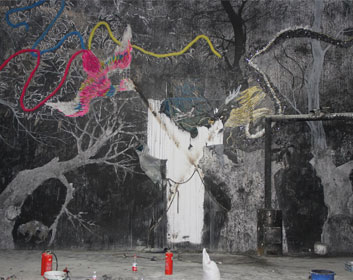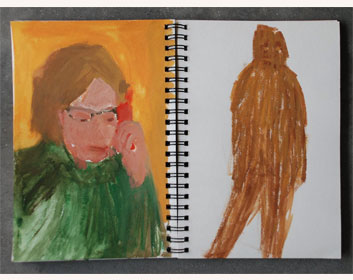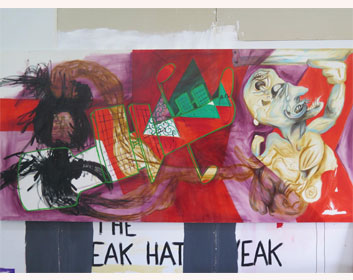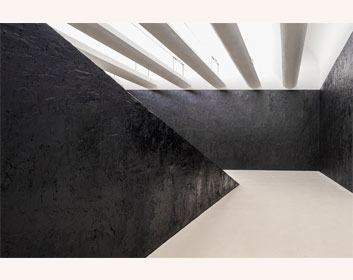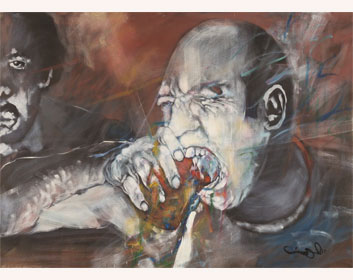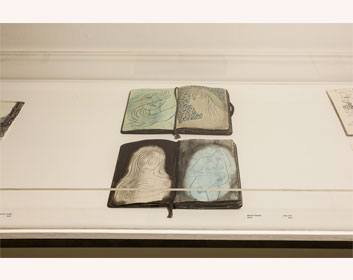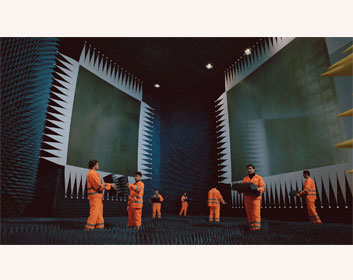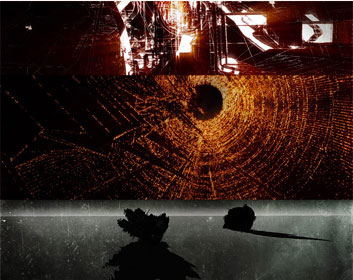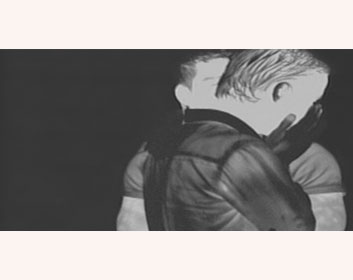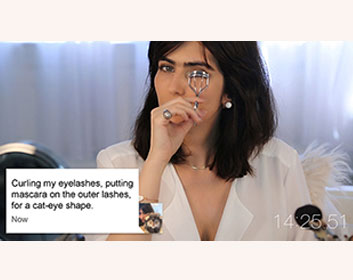-
Zong Ning
The installations of Zong Ning (b. 1984, Mongolia; lives and works in Beijing, China) combine painting, photography, and found objects, and in many cases performances, too. His works draw on Chinese culture yet also make reference to western culture. Zong Ning’s works often engage with conceptual pairs considered opposites by western culture, such as exterior and interior, micro and macro, chaos and order, or life and death; however, in Chinese culture, which regards Yin and Yang as inextricable
read more >> -
Open Sketchbooks No. 2
Sketchbooks allow us an intimate look at one of the elements of the creative process. Their use does not require a specific place or financial resources. This accessible, traditional format allows the drawing or writing hand free – at times automatic or offhanded – expression. A sketchbook may also reflect a rejection of the romantic notion of the muse as inspiration, revealing instead the artist’s painstaking daily efforts and discipline.
read more >> -
Avi Nevo
The works of Avi Nevo (b. 1980) seem like the fruit of true despair, which grow neither from coming to terms nor from rebellion but rather from the involuntary, instinctive movement of a hopeless body. Accumulations of despairing moves, with one’s back to the wall. Not an attempt to break free of one’s shackles, but rather shaking the body like the spasm of a cultural and aesthetic organism which realizes it has reached a dead end,yet the blood still insists on flowing through it and
read more >> -
Orly Sever
Rich, dense, black materiality is typical of Orly Sever’s sculptural installations, which have been on view at the Herzliya Museum of Contemporary Art (2005), Haifa Museum of Art (2008), and Tel Aviv Museum of Art (2015). Her work opens up a mentalscape encoded in matter; it offers an abstracted, pithy move presented through signs of the creative body’s action, and its material expression is both enticing and repulsive. A persistent ritual act leaves in the material charged traces that combine
read more >> -
Uri Lifshitz
Uri Lifshitz (1936-2011), a virtuoso who engaged in painting, sculpture, etching, collage, and drawing, is one of the most prominent and talented artists to have worked in Israel. He is also one of the most controversial. The exhibition title points to an artistic and biographical study of Lifshitz; an exploration of the human figure in his work; and a consideration of both in a cultural and social context. For six decades, starting in the 1960s, Lifshitz produced an extensive, varied, challenging
read more >> -
Open Sketchbooks
Sketchbooks allow us an intimate look at one of the elements of the creative process. Their use does not require a specific place or financial resources. This is an accessible traditional format that allows the drawing or writing hand free expression – at times automatic or offhanded. A sketchbook may also reflect a rejection of the romantic notion of the muse as inspiration, revealing instead the artist’s painstaking daily efforts and discipline. In the late fourteenth century artists increasingly
read more >> -
Julian Rosefeldt
The narrative videos produced by Julian Rosefeldt (b. 1965, Germany; lives in Berlin) often address the ritual aspects of daily life, which express a wish to find meaning in our lives by imposing order on the chaos surrounding us. His works, referring to different sectors in society, stretch the boundaries of engaged art through aesthetics aimed at arousing the viewer’s empathy. Rather than “aesthetic correctness,” he says (in analogy to the concept of “political correctness”), he prefers
read more >> -
Ran Slavin
Ran Slavin’s exhibition at the Herzliya Museum of Contemporary Art is composed of several video, sound, and light installations. Together, they present a split image that transpires intensively and cyclically in several places simultaneously. The museum’s large gallery, whose unique ceiling windows allow daylight to penetrate, has been sealed and darkened by the artist. Within the gallery there is endless flickering artificial light originating in split screens, red LED light lines, flicker
read more >> -
Leigh Orpaz
The end of the world does not lurk in the future, nor has it already transpired in the past. It is happening at this very moment. The barely hidden attraction to disaster obscures the fact that true catastrophe is not an event. The world does not end with a bang. Rather, it fades, frays, and fragments. The reasons for this are rooted in the past, but are so far removed from the ongoing present they seem like sheer whimsy. If the end is already behind us, then the future is merely a chain of repetitions.
read more >> -
Talia Link
“Life style” is more than just a way of life – it’s the way to the good life, a code for leisure time and a clear characteristic of the Western dream of globalism. Life style is a vital component in creating a contemporary identity. It’s the way we aspire to produce ourselves. In the past, the consumerist system marketed life experiences designed to help us appear like we belong to a particular ocial class; today it revolves around self-individualization. The individual is required
read more >>
